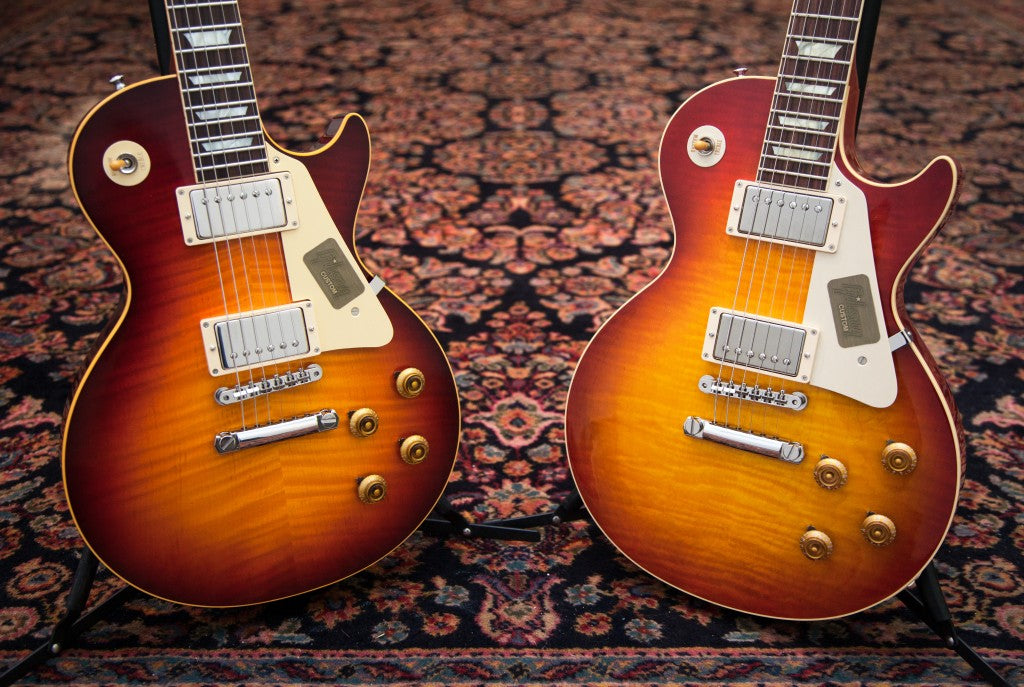True Historic Plastics: Vintage Gibson Reproduction Parts, Inside and Out
From Gibson-
Parts found on original 1950’s Les Pauls are a collector’s universe all on to their own. Individual parts can fetch thousands, while complete sets in the right condition can creep into the tens of thousands. For the few remaining original guitars in the world, there are even fewer options when it comes to replacing parts with the same general vintage. Like any other collectibles, a language has evolved around them as well: an M69 is a pickup ring, while the tool marks and imperfections on them are classified with colorful terms like “drooling” and “flash”. It would be a while before Gibson would take a leadership role in the replication of original parts. When we did, we did so with an unprecedented level of research, engineering and results.
There has been an extensive aftermarket around replacement parts for modern Gibson Custom reissues for some years, a result of demand for parts that more closely resemble those we made in the 1950’s, right down to the tiniest detail. A full set of plastics considered more authentic looking than our own Historic Reissue plastics, runs anywhere from $500-$700. Many of these are very good cosmetically, though no one had as of yet actually analyzed original examples from the inside out. Even we had focused on the cosmetic “accuracy”, albeit without going so far as to replicate tooling marks and imperfections. From 1993 to 2014, we reformulated the color and shape of key plastic parts like the pickguard, switchwasher ring and jackplate. The evolution of the Historic Reissue had always been primarily focused on the tone and feel of the original 50’s and early 60’s Les Pauls, so the cosmetic had yet to get the same attention.
In 2015, Gibson Custom was the first to reproduce parts based on the material composition of original Gibson plastics and our own engineering archives, making True Historic plastics the only real authentic reproductions available. We decided to study at the molecular level because color, shape and markings were incomplete data. Color on an original ’59 Les Paul part, for example, was a complete unknown. All anyone could know is what a forty year old part looked like today, not what it looked like in 1959. Also unknown was how these parts were constructed from the inside. Even our own Engineering data gave only outer dimensions to work from. To know exactly what materials were used to create them and how they were made nearly half a century a go, we’d have to go deeper.
We began by reaching out to the collector community to purchase original parts, some of which were sent to a third party lab to be destroyed and their materials composition studied. Others were studied for their construction. As few as possible were sacrificed, of course and we relied on Engineering archives when we knew they provided indisputable data.
What we emerged with was fascinating, even to us. As it turns out, for example, a vintage Les Paul pickguard jackplate is made up of several laminated layers of the same material as the rhythm/treble switchwasher. The pickguard is the same material and thickness, again laminated a few more times for its thickness. And while we (and everyone) were fairly certain that the color difference between the pickup rings and the pickguard on an original was evidence of different materials being used, it wasn’t until the lab analysis came back to prove it that it was proven.
From there, we relied on physical observation and Engineering files to reproduce exact outer measurements as well as minutia such as the tooling marks, imperfections, etc.
 If you look closely at a True Historic pickup ring for example, you’ll see the “M” in “M-69” has a weak left leg, and that there are three mold marks across the underside of the outer rim. You’ll also notice that the two screw shafts are asymmetrical. The side by side photos show both an original and a True Historic part. To identify the original, it helps to look for the red “bleed” from years of contact with an original Gibson’s finish.
If you look closely at a True Historic pickup ring for example, you’ll see the “M” in “M-69” has a weak left leg, and that there are three mold marks across the underside of the outer rim. You’ll also notice that the two screw shafts are asymmetrical. The side by side photos show both an original and a True Historic part. To identify the original, it helps to look for the red “bleed” from years of contact with an original Gibson’s finish.
Does any of this effect the tone? Probably not. However the goal remains to continually evolve the True Historic series to capture as many details as possible as found in our originals. Some will always be out of reach based on real world changes like laws that prohibit certain materials to be used or safety certification that effects guitar craft (lead-free solder for example), but in the few areas left to address, we will continue to strive to bring a level of replication unsurpassed for those that find value in it. True Historic plastics move us one step further down that path.

















